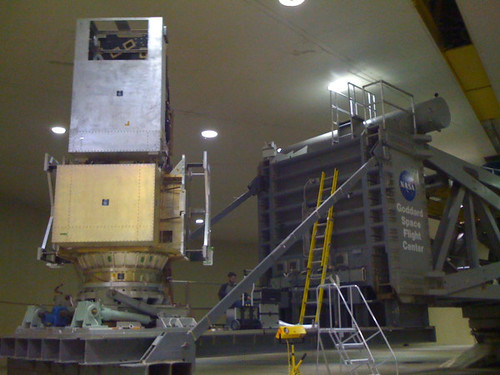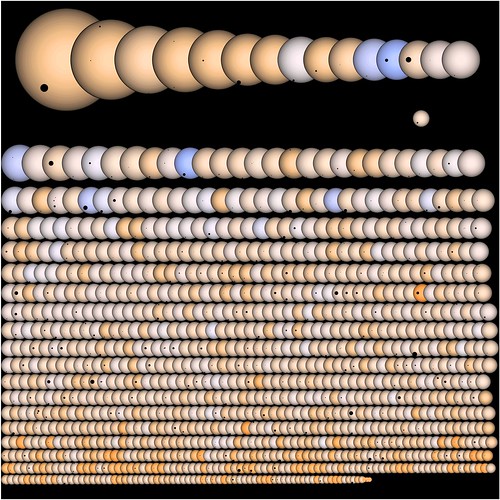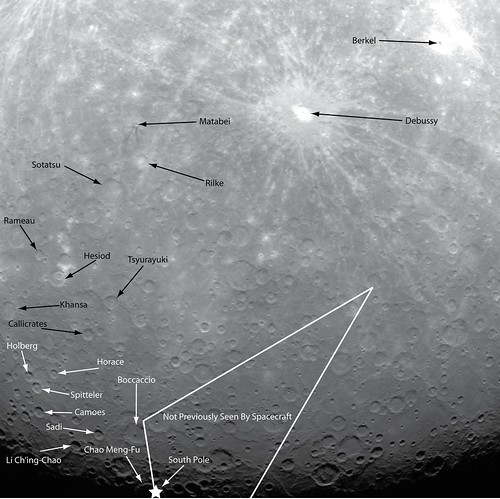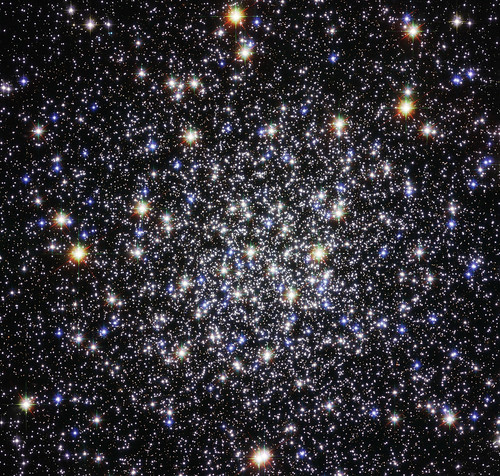Awesomeness Round-up – 4/4/11
- By Sara Mitchell
- April 4, 2011
- 1 Comment
In honor of the 30th anniversary of the Space Shuttle Program, employees down at Kennedy Space Center came together for this impressive themed aerial portrait. I’m not sure what image we would pick at Goddard, since the research here is so diverse! Any ideas? Post them in the comments!
There’s a lot more awesomeness below… last week was a busy one for space stuff!
Meet globular cluster Messier 12, as seen by the Hubble Space Telescope. With so many stars packed together, it’s a lovely thing to behold. But it’s also a dangerous place to live for a star, because those close quarters are home to binary star systems where one star is being torn apart and consumed by its companion! These tightly orbiting binaries give off plenty of X-rays for astronomers to study. Researchers using the Very Large Telescope in Chile have studied M12 and discovered that its population of low-mass stars is smaller than expected – leading to speculation that nearly one million low-mass stars may have been violently ripped away from the object during its orbit around the galactic center. Ouch.
Want to learn more about the James Webb Space Telescope? The mission has released a new video with astrophysicist Amber Straughn (you might recognize her from Webb Gotchu) demonstrating how cold the Webb will be in space, and answering some frequently asked questions about the satellite.

Credit: NASA/GSFC/Rebecca Roth
Just a couple of weeks after the ISIM went for a ride on Goddard’s centrifuge, they gave something else a spin! This time, it’s a whole satellite – or, really, a combination of flight hardware parts and a “mass model” to simulate the size, shape and weight distribution of the finished satellite. This testing model of the Global Precipitation Monitor (GPM) satellite was spun up to just over 10 RPM last week, in a test to see how the satellite will handle the rigors of launch.
Blueshift’s Maggie Masetti was over there while they were setting up and snapped a camera phone picture:

Credit: Maggie Masetti
Next week the ISIM structure (which will hold the James Webb Space Telescope’s instruments) is due to be tested on the centrifuge. It’s an exciting time, because the centrifuge often goes for a while without any tests going on.

Credit: Jason Rowe, Kepler Mission
This image has every single planetary candidate host star that the Kepler mission has spotted, with their companion planet(s) in silhouette against them. That’s 1,235 candidate planets since the mission began in 2009! Everything in this image is to scale, with our Sun (which has the silhouettes of Earth and Jupiter upon it) shown below the top row on the right for comparison. The colors of the stars represent how the eye would see each of them from outside of the Earth’s atmosphere. It’s pretty amazing to think that just over 15 years ago, exoplanets were just speculation… and now we’re finding them regularly, all over our galaxy. Click the image for a larger version, and check out all of the tiny planets!
It wouldn’t be a round-up without some news about the awesome things happening on the Sun! The Sun gets busy on a cycle, and the Sun’s activity is currently ramping up towards solar maximum.
Credit: NASA/GSFC/STEREO
STEREO captured this large coronal mass ejection (CME) coming from the far side of the Sun, which meant that it didn’t send any particles towards Earth.
Credit: NASA/GSFC/SOHO/SDO
This video compares data from SOHO taken exactly two years ago (left) and current data from the Solar Dynamics Observatory (right) to show how active the Sun has become in just a couple of years. As we said, we’re still headed towards the solar maximum… so I’m sure the Sun’s awesomeness will be featured in many round-ups to come!
The orbit of SDO takes it into an “eclipse season” twice a year where the satellite’s view of the Sun is obscured by the Earth for up to 72 minutes each day. Here’s one of the “eclipses” that it saw last week, where the varying density of our planet’s atmosphere is blocking out different amounts of light to create that rough edge. Brighter spots on the Sun may still make it through, and the overall effect is just eerie!

Credit: NASA/Johns Hopkins University Applied Physics Laboratory/Carnegie Institution of Washington
As mentioned a couple of weeks ago, MESSENGER has begun sending back incredible images of Mercury! The image above is an annotated version of the historic first orbital image of Mercury captured by the satellite last week. The labels indicate several craters that were named based on Mariner 10 images, as well as Debussy, Matabei, and Berkel, which were named based on MESSENGER flyby images. The images being released are simply astonishing, showing a level of detail of the planet’s surface that we’ve never had before.

Data Credit: Marc Imhoff (NASA/GSFC) & Christopher Elvidge (NOAA NGDC)
Image Credit: Craig Mayhew & Robert Simmon (NASA/GSFC)
Finally, here’s an oldie but a goodie – this image of the Earth’s city lights is one of the most-requested pieces of NASA imagery! The image was created with data from the Defense Meteorological Satellite Program (DMSP) Operational Linescan System (OLS), which was designed to view clouds by moonlight but also does a great job capturing the location of lights! We included this image in this week’s round-up because we are often asked where it can be downloaded… here you go!





There’s a bunch of pics of that centrifuge on the Sun/Earth Day flickr pool, for those trying to get an idea of the scale of that thing: http://www.flickr.com/groups/sed2011/